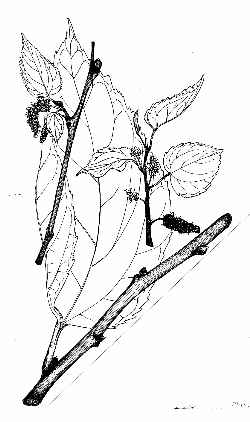
Britton, N.L., and A. Brown. 1913. Illustrated flora of the northern states and Canada. Vol. 1: 631.
Sunset®: 4-24
USDA: 6-10
Sun Exposure: Full sun
Origin: Middle East
Growth Habits: Small to medium-sized tree, slow growing to 30 feet tall (6-15 m); dark grey trunk; the light green leaves are 2 to 5 inches long (5-12.5 cm), 3 to 6 inches wide (7.5-15 cm); 'Stribling' has maple-shaped leaves
Propagation: Seeds, cuttings, or graftings
Blooming Habits:
The white mulberry is dioecious (occasionally monoecious), male and female catkins are 1 to 3 inches long (2.5 to 7.5 cm) in early spring, the male flowers being narrower.
Fruiting Habits:
Dark purple to black drupes, 0.5 inch (1.3 cm) long, in early summer. The unripe fruits shouldn't be eaten as, like the mulberry sap, slightly toxic. The fruits may be eaten raw or cooked, they are generally much sweeter and tastier than the ones of the more common Morus alba. The fruits can be a nuisance when the tree is placed over concrete surface can be stained by the falling fruits.
Desert-Tropicals is dedicated to provide gardening advice, gardening ideas, and information about flower of all kind for landscape and collections.We try to check carefully the identification of the plants on the illustrations as well as the other information from the page, but occasionally errors do occur. if you notice anything that needs to be changed please contact us.Thanks.
© 1998-2020 Philippe Faucon, All Rights Reserved.